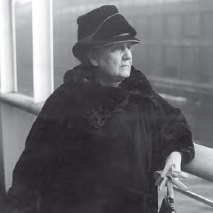American PhilosophyJane Addams |
Who was Jane Addams? |
Dewey called the aesthetic qualities of experience “tertiary qualities.” Because experience is a kind of transaction, the aesthetic quality of an experience can change and become more meaningful toward a “consummation.” A consummation is the reconstruction of an experience by intelligence: for example, solving a problem. What is not aesthetic according to Dewey is what is slack or overly rigid. There is nothing in either scientific inquiry or practical action that precludes the presence of aesthetic qualities.
Jane Addams (1860–1935) was the first woman public intellectual in the United States. She was a close colleague of both John Dewey (1859–1952) and George Herbert Mead (1863–1931). In 1931 Addams was awarded the Nobel Peace Prize for her progressive public activities in beginning the settlement house movement. The settlement movement involved locating places for assisting members of impoverished immigrant communities, directly in their neighborhoods. Addams began the services of Hull House with art appreciation classes and quickly developed a program of education for youth, child care, instruction in domestic skills, and adult education. She was only “recovered” as a philosopher and feminist in the late-twentieth century. Her main works include Democracy and Social Ethics (1902), Newer Ideals of Peace (1906), Twenty Years at Hull House (1910) and Second Twenty Years at Hull House (1930), The Long Road of Woman’s Memory (1916), and Peace and Bread in Time of War (1922).

